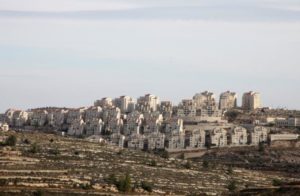When the Settlement Bloc Expands

Part of the Gush Etzion settlement bloc
Amira Haas writes in Haaretz, 10 December 2019, “If, seven years from now, settlers declare that the Palestinian village of Atara, north of Ramallah, endangers them because of its high location and proximity to the road, and demand that its homes be emptied, what will the army’s district brigade commander and Central Command chief do? What will they do if the declaration is accompanied by violence and vandalism targeting the villagers, and later mass prayers at the entrance to the village? Judging by previous experience, it’s likely that the senior officers will send soldiers to protect the Israeli citizens during their assaults and their prayers, and might even shoot at Palestinians who dare to protest.
But we cannot rule out the possibility that the commanders will also find or invent an appropriate order allowing them to permanently expel the villagers from their homes, because that’s what the settlers demand. Go to Ramallah, there are lots of vacant apartments there, the Civil Administration officers will say as they come to deliver the expulsion orders.
We hope the residents of Atara will forgive us for using them as an example in such a horrifying script. On the one hand, its feasibility should not be ruled out, while on the other hand, telling this tale is yet another attempt, perhaps desperate, to prevent it or similar horror scenarios from happening.
Every settlement and settlement outpost in the West Bank, including in East Jerusalem and in Hebron, constantly expands its boundaries at the expense of the Palestinian space, forcing the Palestinians into territorial pockets that are increasingly shrinking. This is done through institutional violence (cabinet resolutions and their implementation by the Civil Administration, municipalities, settler councils and military jurists) or the supposedly “private” violence of settler thugs.

Map of expansions in the Gush Etzion settlement bloc
The expansion isn’t solely geographic. It involves the constant crossing of new red lines of what is permitted and what is forbidden, in terms of political, ethical, legal and humanitarian considerations. Every settlement expansion is the result of acclimation to the gradual violation of laws and norms. Every expansion increases the ability of the settlers and the planners to imagine the erasure of the next red line and the addition of another ring of control.
The concept underlying this constant physical and behavioral expansion is that Jews are a superior race, particularly those who have settled in the West Bank. The number of those consenting or collaborating with the concept and the associated violence (either actively or by ignoring and getting used to it) is also growing.
Since the middle of June, settlers in the Shiloh bloc (which is built on and is expanding into the lands of the villages of Qaryut, Jalud, Turmus Ayya and Mughayer) have aimed their violence and media spearheads at a small Palestinian real estate project in Turmus Ayya. At the end of October, Binyamin Regional Brigade Commander Colonel Yonatan Steinberg and Central Command chief Major General Nadav Padan capitulated to settler aggression and ordered developer Khaled Al Sabawi, a Palestinian who is a Canadian citizen, to freeze construction work on land that his company, UCI, purchased there at the beginning of the year.
Since the late 1990s, the violence of the Shiloh bloc settlers has been aimed at Area C — constituting 62 percent of the West Bank, it is under Israeli administrative and military control and Palestinian construction is prohibited — leading to their seizing control of thousands of dunams from the above-named villages. Now they have gone a few steps further, and their aggression is targeting Area B (some 18 percent of the West Bank, where Palestinians have planning authority but the security is in Israel’s hands). These artificial A, B and C divisions, originating with the Oslo Accords, were meant to be temporary but have become permanent, and the settlers and Israeli authorities use them as they please.
Now the security pretext is being used to stop Sabawi’s project of readying lots for construction and selling them to Palestinians with roads, sidewalks and electricity infrastructure already in place. Rewarding settlers for violence is disturbing in and of itself, but even more so because of the behavior patterns the settlers have developed, either as emissaries of the authorities or with their assistance. Their message is clear; Area B is also in our sights. Today we will ban Palestinian construction there, tomorrow we will open the land for our Jewish construction and agriculture, and the day after that we will expel the Palestinians who live there.” This article is printed in its entirety
